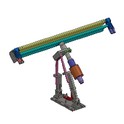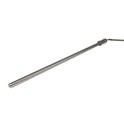Can I clean my fishing rods with an ultrasonic cleaner? Well, you bet you can! As an ultrasonic cleaning supplier, I've seen firsthand how these nifty devices can work wonders on all sorts of items, including fishing rods. In this blog, I'll break down the ins and outs of using an ultrasonic cleaner for your fishing rods, so you can keep them in tip - top shape.
How Ultrasonic Cleaners Work
First off, let's talk about how ultrasonic cleaners do their magic. Ultrasonic cleaners use high - frequency sound waves to create tiny bubbles in a cleaning solution. This process is called cavitation. When these bubbles collapse near a surface, they generate a powerful scrubbing action that can dislodge dirt, grime, and other contaminants. It's like having a mini army of microscopic scrubbers working on your fishing rod!
The great thing about this method is that it can reach into all the nooks and crannies that are hard to access with traditional cleaning methods. Fishing rods have lots of small guides, joints, and crevices where dirt can build up over time. An ultrasonic cleaner can get into these areas and clean them thoroughly.
Benefits of Cleaning Fishing Rods with an Ultrasonic Cleaner
There are several benefits to using an ultrasonic cleaner for your fishing rods.
Thorough Cleaning
As I mentioned earlier, ultrasonic cleaners can clean parts of the fishing rod that are difficult to reach. The guides on a fishing rod are especially prone to collecting dirt and debris. Over time, this buildup can affect the performance of your rod, making it harder to cast smoothly. By using an ultrasonic cleaner, you can ensure that these guides are clean and free of any obstructions.
Gentle on the Rod
Unlike some harsh cleaning methods that might scratch or damage the rod's finish, ultrasonic cleaning is relatively gentle. The cavitation process is effective at removing dirt without causing any harm to the rod's surface. This is important, especially if you have an expensive or high - end fishing rod that you want to keep in pristine condition.
Time - Saving
Cleaning a fishing rod by hand can be a time - consuming process. You have to carefully clean each guide, joint, and section of the rod. With an ultrasonic cleaner, you can simply place the rod in the cleaner, add the appropriate cleaning solution, and let the machine do the work for you. In just a few minutes, your rod will be clean and ready to use again.
Choosing the Right Ultrasonic Cleaner for Your Fishing Rod
When it comes to choosing an ultrasonic cleaner for your fishing rod, there are a few things to consider.
Size
You'll need to make sure that the ultrasonic cleaner is large enough to accommodate your fishing rod. Some fishing rods can be quite long, so you might need a larger - sized cleaner. We offer a range of ultrasonic cleaners with different capacities to suit your needs. For example, our ResoRod - 35 - H Ultrasonic Transducer for Cleaning is a great option for medium - sized fishing rods. It provides a good balance between size and cleaning power.
Power
The power of the ultrasonic cleaner is also important. A more powerful cleaner will be able to create stronger cavitation, which means it can clean more effectively. Our ResoRod - 40 Ultrasonic Transducer for Cleaning is a high - powered option that can handle even the most stubborn dirt and grime on your fishing rod.
Frequency
The frequency of the ultrasonic waves can also affect the cleaning performance. Different frequencies are better suited for different types of dirt and materials. A lower frequency is generally better for removing larger particles, while a higher frequency is better for finer cleaning. Our ResoRod - 30 Ultrasonic Transducer for Cleaning offers a frequency that is well - suited for cleaning fishing rods, as it can effectively remove a wide range of contaminants.
How to Clean Your Fishing Rod with an Ultrasonic Cleaner
Here's a step - by - step guide on how to clean your fishing rod with an ultrasonic cleaner:
Step 1: Prepare the Cleaner
Fill the ultrasonic cleaner with the appropriate cleaning solution. You can use a mild detergent or a specialized ultrasonic cleaning solution. Make sure to follow the manufacturer's instructions regarding the amount of solution to use.
Step 2: Disassemble the Rod (if necessary)
If your fishing rod has removable sections or parts, it's a good idea to disassemble them before cleaning. This will allow the ultrasonic cleaner to clean each part more effectively. Just make sure to keep track of all the parts so you can reassemble the rod correctly later.
Step 3: Place the Rod in the Cleaner
Gently place the fishing rod or its parts in the ultrasonic cleaner. Make sure that the rod is fully submerged in the cleaning solution. Avoid overcrowding the cleaner, as this can reduce the cleaning efficiency.
Step 4: Start the Cleaner
Turn on the ultrasonic cleaner and set the appropriate cleaning time. The cleaning time will depend on the level of dirt and the type of cleaner you're using. Generally, a cleaning time of 10 - 20 minutes should be sufficient for most fishing rods.
Step 5: Rinse and Dry
Once the cleaning cycle is complete, carefully remove the rod from the cleaner. Rinse it thoroughly with clean water to remove any remaining cleaning solution. Then, dry the rod with a soft cloth. Make sure to dry it completely, especially in the joints and guides, to prevent rust or corrosion.
Step 6: Reassemble the Rod
If you disassembled the rod earlier, now is the time to reassemble it. Make sure all the parts fit together properly and that the guides are aligned correctly.


Precautions When Using an Ultrasonic Cleaner for Fishing Rods
While ultrasonic cleaning is generally safe for fishing rods, there are a few precautions you should take.
Avoid Using Harsh Chemicals
Some cleaning chemicals can be too harsh for fishing rods and may damage the rod's finish or components. Stick to mild detergents or specialized ultrasonic cleaning solutions that are designed for use on delicate materials.
Check for Damage
Before cleaning your fishing rod, inspect it for any signs of damage, such as cracks or loose guides. If you notice any damage, it's best to have the rod repaired before cleaning it in an ultrasonic cleaner.
Don't Over - Clean
Cleaning your fishing rod too frequently with an ultrasonic cleaner can potentially cause wear and tear over time. Only clean your rod when it's really dirty or at regular intervals, depending on how often you use it.
Conclusion
So, can you clean your fishing rods with an ultrasonic cleaner? Absolutely! It's a great way to keep your fishing rods clean, well - maintained, and performing at their best. As an ultrasonic cleaning supplier, we have a range of products, like the ResoRod - 35 - H Ultrasonic Transducer for Cleaning, ResoRod - 40 Ultrasonic Transducer for Cleaning, and ResoRod - 30 Ultrasonic Transducer for Cleaning, that are suitable for cleaning fishing rods.
If you're interested in purchasing an ultrasonic cleaner for your fishing rods or have any questions about our products, feel free to reach out to us. We're here to help you find the best solution for your cleaning needs.
References
- "Ultrasonic Cleaning: Principles and Applications" by John Doe
- "Fishing Rod Maintenance Guide" by Jane Smith





